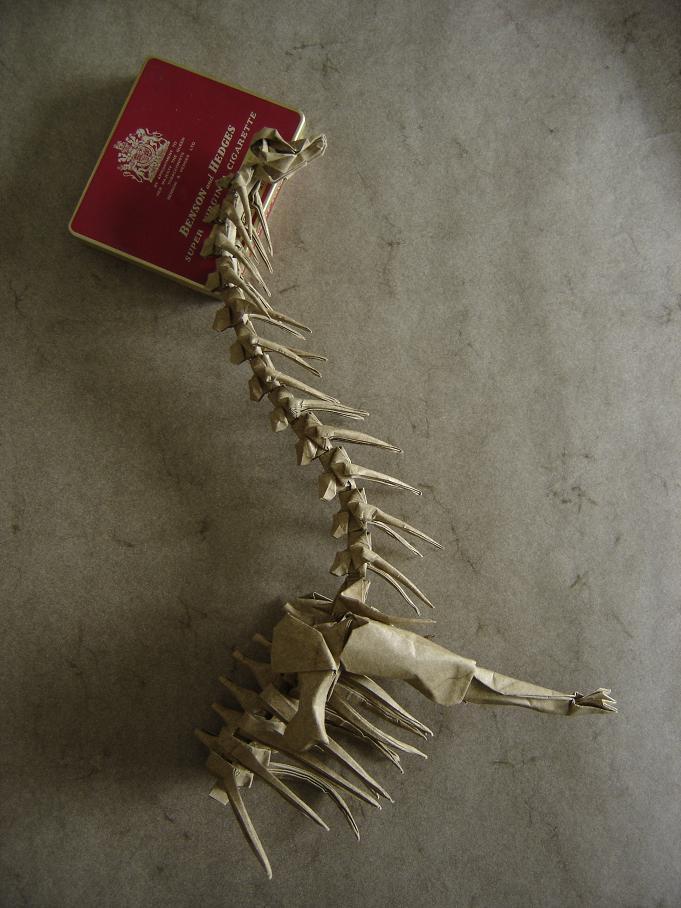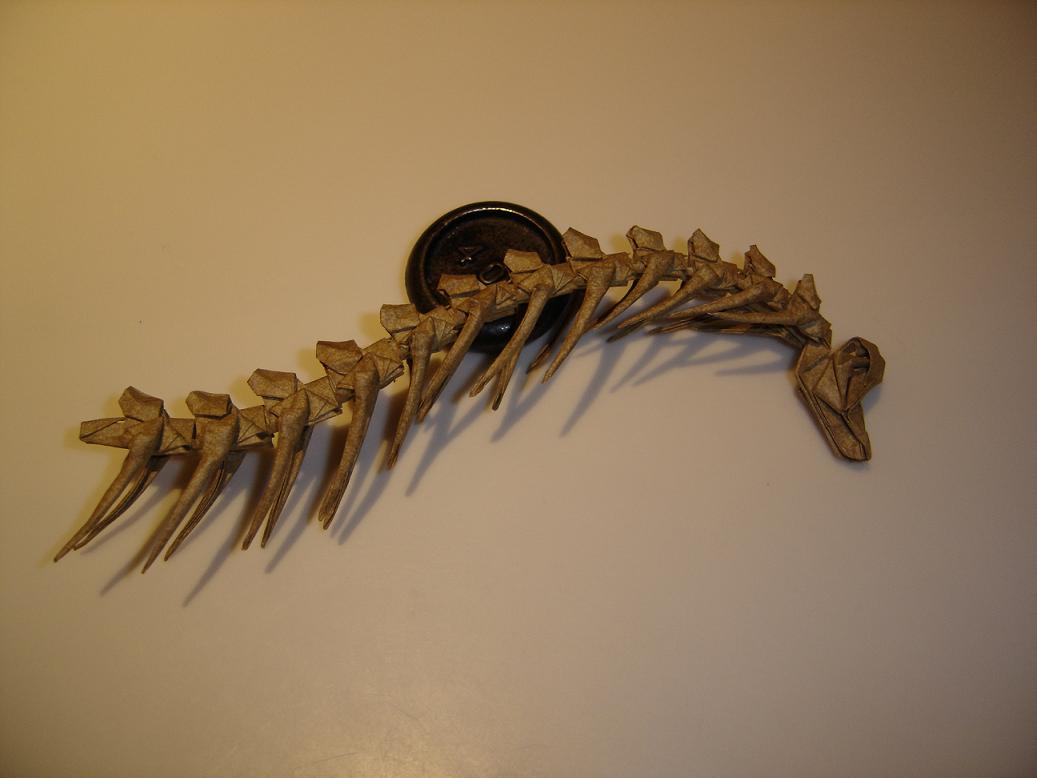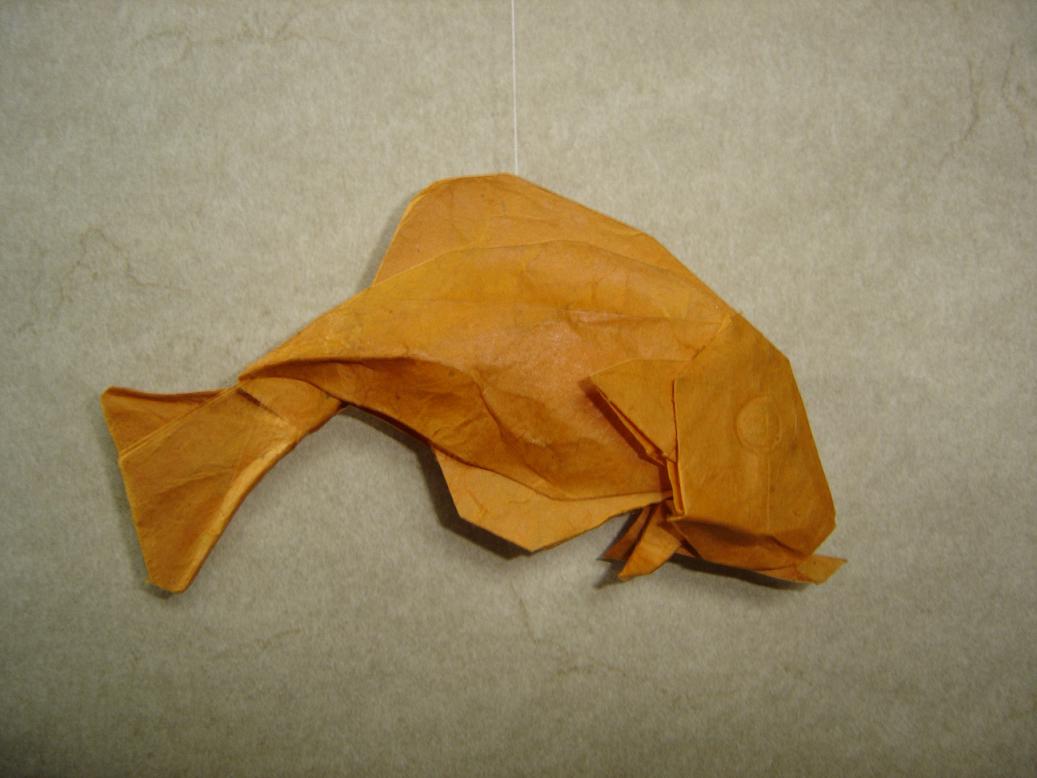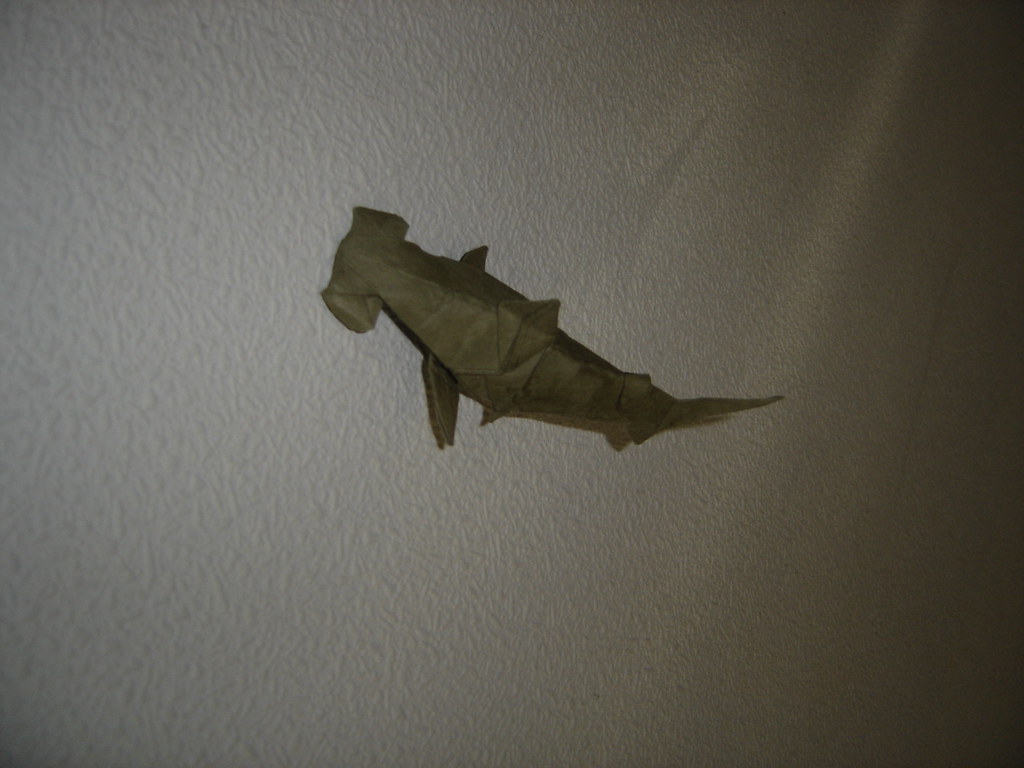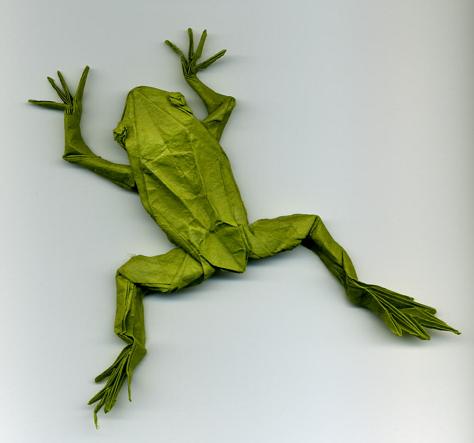Monday, 10 November 2008
Giant Mekong Catfish
Yesterday I watched a wildlife documentary about the freakishly large Goonch Catfish which have allegedly been preying on humans along a five mile stretch of the Kali river, in India. The explanation given for this unexpected reordering of the food chain (which previously placed man above blackened Catfish steaks) is that the fish acquired their taste for human flesh as a result of scavenging burnt remains from the riverside funeral pyres.
Villagers living in the area where the attacks took place claim that these monsters are able to suck their prey into their giant gaping mouths from a few feet away. Now I am going to have to use up one of my three wishes ensuring that I don’t meet my end being sucked to death by a three meter long catfish; not when the relative dignity of a Crocodile or Bull Shark attack are still options.
I was sufficiently intrigued by the programme to fold Mizuno Ken’s Giant Mekong Catfish. It’s a simple, abstract model that even a novice could have a go at. The formation of the flat mouth helps to round out the belly and make the body three dimensional.
Wednesday, 30 July 2008
Brachiosaurus Skeleton (part two)
Having assembled small sections of the skeleton I found that, while most of the pieces of slot together quite well, it doesn't take a lot to separate them. There are also some problematic areas, such where the front legs join with the rib cage; these won't stay in place at all. For the model to have any kind of structural integrity it needs to be glued together.
Another not entirely unforeseen problem is that the neck won't support its own weight. I am going to get around this by securing a length of stiff wire along its underside. I will probably do likewise with the tail.
The leg in the foreground is a mock-up. I folded it very quickly just to get an idea of how tall the finished model would be (just under 10 inches). When I refold it I will try to bring out the shape of the bones and attempt to make the toes appear a little more skeletal than they are in the design.
Wednesday, 9 July 2008
Brachiosaurus Skeleton (part one)
The majority of origami models begin their existence as uncut squares of paper. Complex dinosaur skeletons (like the one above, designed by Fumiaki Kawahata) differ in that they are modular creations, assembled from many pieces, all of which are folded separately.
The neck section of this Brachiosaurus incorporates 13 small squares of paper of varying sizes (6-8cms) - one for the skull and one for each of the 12 vertebrae. The completed skeleton uses 45 squares. The finished pieces seem to slot together quite well. I am cautiously optimistic that I can assemble the model without resorting to glue.
Friday, 13 June 2008
Dromedary

John Montroll is a well-known figure in contemporary origami. He has published numerous themed collections of original designs. In the days when internet shopping was still in its infancy and sourcing origami manuals was extremely difficult, his books were always readily available and a good next step for those who were ready to move on from traditional models.
Throughout the 1990s, Montroll maintained a frenetic work rate. At one point it looked like he wouldn’t rest until he had created a paper facsimile of every member of the animal kingdom. In recent years he has slowed down. In his absence origami has moved on and his work has been overshadowed by more sophisticated designs, leaving him slightly undervalued.
This dromedary, while slightly angular, has aged very well. The face neck have a lot of character. Many years ago in the
Saturday, 7 June 2008
Fish
Of all the master paper folders, the Frenchman, Eric Joisel, is perhaps the most expressive and, dare I say, artistic in his approach. You can find a gallery of his animal models here.
Saturday, 31 May 2008
Horseshoe Crab

Of all the techniques that have become part and parcel of modern origami, Wet Folding must be the most indispensable. This involves dampening the paper slightly before making the creases. The added moisture temporarily dissolves the sizing (the water-soluble adhesive that holds the paper together) allowing the fibres to be shifted and then set in a slightly different position. In essence you are manipulating both the shape of the paper and its underlying physical structure. This enables folders to sculpt the material, creating softer, longer-lasting creases and curves, which add an element of realism to models.
Wet folding was the brainchild of Akira Yoshizawa - the father of modern Origami, whose goal was to create lifelike, three-dimensional animals and plants. One of the first western folders to embrace the technique was Michael LaFosse.
This Horseshoe Crab, designed by LaFosse, is eight inches long. Evidence of wet folding can be seen in the curve of the prosima, which is a little more pointed than I would like - I was hoping for something rounder. My addition to the model is the triangular bulge on its back, which is supposed to represent the raised part of the shell that runs along the centre of the opistoma. This was also achieved by wet folding.
I made the model from Elephanthide paper. I like the way that the camera flash reflected off the shiny surface of the paper, giving the crab the appearance of having just crawled out of the water.
Saturday, 24 May 2008
Grim Reaper
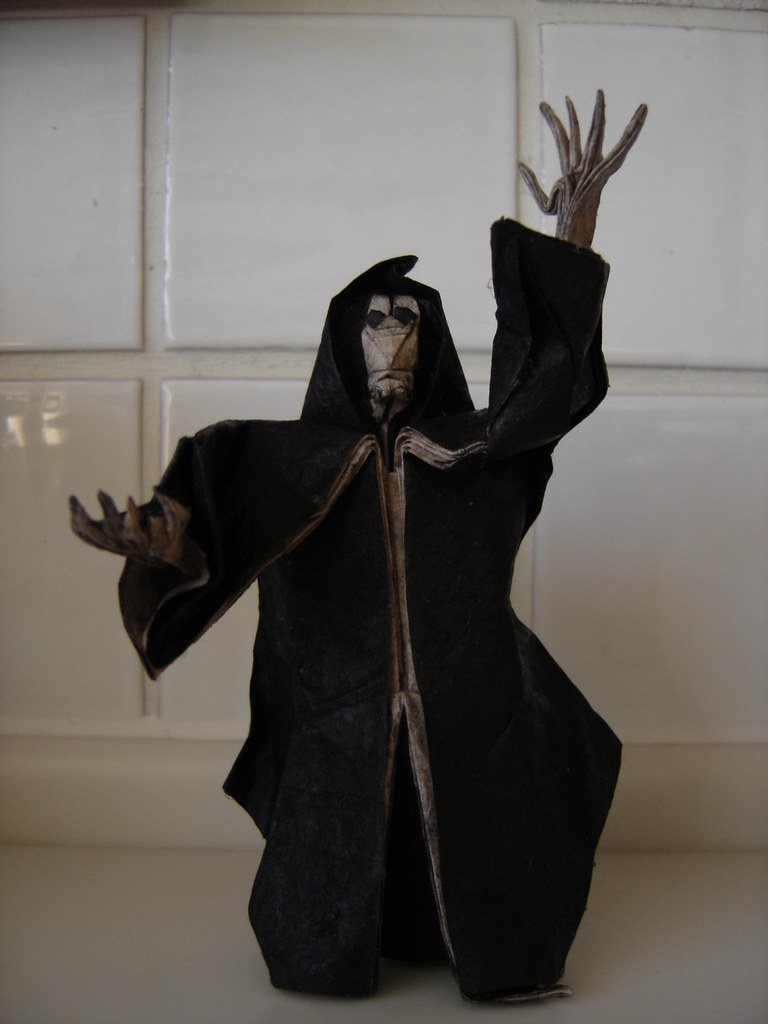
The skull is absolutely tiny - a mere centimetre across and two centimetres in length. I re-folded it three times until I achieved the gaunt appearance I was after.
In positioning the hands I encountered a number of problems. The digits are only white on one side. Furthermore they all the same length and also rather thick. You are very limited in what you can do with them. I attempted a beckoning gesture, which I thought was appropriate given the subject, but couldn’t get it right and compromised with an open-handed grasp, awaiting perhaps the arrival of an origami hourglass.
I sculpted the robe using a dilute solution of wallpaper paste.
One of the hidden strengths of this model is that there is enough spare paper at the back to pinch into a triangular stand, enabling it to remain upright without the need for wire or Blu tack.
Wednesday, 21 May 2008
Pattern Break
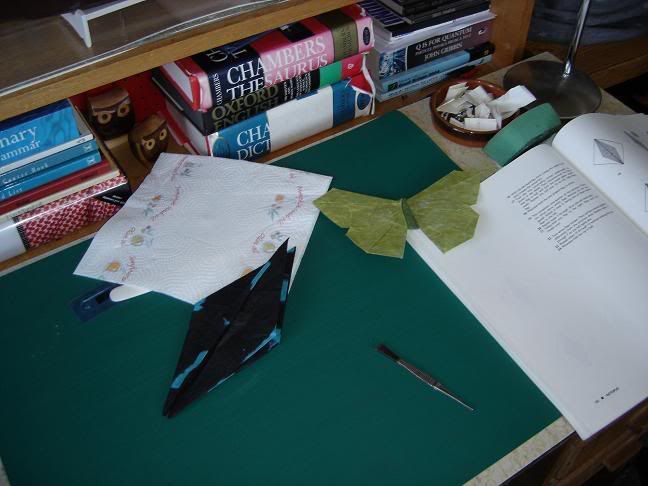
Veteran origami designer, Michael LaFosse, (whose butterfly you can see on the right of this photograph) also designed a very elegant Koi Carp, which he makes from white watercolour paper. He decorates the fish with blotches of red, black and orange paper. You can see an example of it here:
I wanted to do something similar but a bit more random, hence, before folding Peter Engel’s Octopus (pictured in its very early stages to the left of the butterfly), I glued some roughly torn pieces of turquoise khadi paper to a square of black, silk threads tissue. Some of this vivid blue will be visible in the tentacles and the body of the finished model. I hope that it will effectively represent either the play of light in the water, or the octopus’s natural skin pigmentation.
In the same vein, I am folding Jose Maria Chaquet Ulldemolins’ version of the iconic WWII fighter plane, The Spitfire, using a square of brown paper decorated with green strips, in an attempt to mimic the wartime camouflage.
I am also planning more ambitious, regimented collaging that will emulate, for example, the patterning on a giraffe’s hide. It’s an extension of back-coating, whereby two sheets of differently coloured paper are pasted together to produce a bi-coloured model. I think that it’s a much better way of adding colour and texture to a piece of origami than painting.
Saturday, 17 May 2008
Canada Geese

(Click to enlarge image)
A lot of the origami I make ends up hanging from my bedroom ceiling. My idea is that, as you cross the room, you journey through different habitats, beginning in the sky (the area around the door) and ending on the seabed (represented by the ceiling above my bed).
Friday, 9 May 2008
Hammerhead Shark
Unfortunately the anal fin (not visible in the photo) is a weakness in the design. Formed from the tip of a very thick flap of paper which lies inside the model, it proves to be an obstacle when it comes to shaping the body of the shark. I was able to round the tail-section by dampening the paper with water and dilute wallpaper paste and then holding it in place while it dried. Even doing that I never really achieved the slender look I was after. The head is fun to sculpt. I spent ages messing around with it.
I folded this model from an 11 inch square. The end result is about 5.5 inches long from head to the tip of the tail.
Friday, 2 May 2008
Tree Frog
This Tree Frog was designed by Robert J Lang – one of contemporary Origami’s great innovators. I folded it from a 15 inch square of Khadi paper. In posing the model I was inspired by a version of it that I saw on the front cover of an origami calendar some years ago.
Lang is a former physicist turned professional origami designer. In addition to his many amazing animal sculptures (you can see extensive galleries on his website) he has also put origami to more practical uses, developing folding patterns for car airbags and the lense of a space telescope, known as the Eyeglass, which is designed to unfold to a diameter of 100m in orbit.

